Camping Pots - Ultimate Guide For Your Cooking Adventures
🏕️ Discover 2025's best camping pots! Expert buyer's guide, top 5 picks with pros/cons, and essential FAQs for your next adventure.
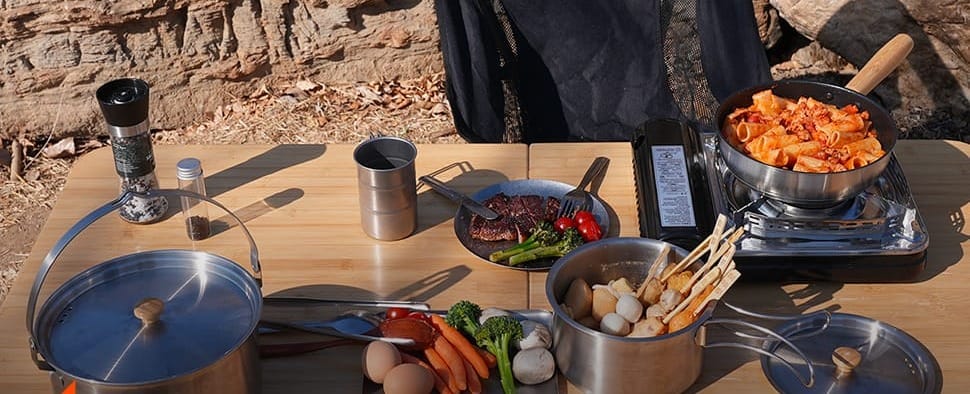
Whether a seasoned backpacker or a weekend car camper, having the right cooking equipment can make or break your outdoor culinary experience. Camping pots are essential for everything from boiling water for morning coffee to preparing hearty stews under the stars.
With countless options, choosing the perfect pot for your specific needs can be overwhelming. This comprehensive guide will walk you through everything you need to know about camping pots and highlight five outstanding options available online to elevate your outdoor cooking game.
How to Find the Best Camping Pots
Buyer's Guide
Material Considerations
The material of your camping pot significantly impacts its weight, durability, and cooking performance:
Stainless Steel: Exceptionally durable and relatively inexpensive, stainless steel pots withstand rough handling and high temperatures. They're ideal for car camping but may be too heavy for backpacking. Many feature tri-ply construction with an aluminum core for improved heat distribution.
Aluminum: Lightweight and affordable, aluminum pots heat up quickly but aren't as durable as other materials. Hard-anodized aluminum offers improved durability and scratch resistance while remaining lightweight.
Titanium: The ultralight champion, titanium pots are incredibly durable and corrosion-resistant. They heat quickly but may develop hot spots. Despite their premium price, they're favored by ultralight backpackers who count every ounce.
Cast Iron: Heavy but exceptional for car camping, cast iron offers unmatched heat retention and cooking performance. It's naturally non-stick when properly seasoned and extremely durable.
Weight and Portability
For backpackers, weight is a crucial consideration. Every ounce matters when you're carrying your kitchen on your back. Titanium and aluminum pots offer the best weight-to-performance ratio. Look for nesting designs and foldable handles that minimize packed size.
Size and Capacity
Consider how many people you'll be cooking for and what types of meals you plan to prepare:
- Solo campers: 0.75-1.5 liter capacity
- Duo campers: 1.5-2.5 liter capacity
- Group camping: 2.5+ liter capacity or multiple pots
Remember that larger pots mean more weight and bulk, so find the right balance for your needs.
Heat Efficiency
Some pots feature heat exchangers or flux rings on the bottom, which can significantly reduce boiling time and fuel consumption. These features are especially valuable in windy conditions or at high altitudes where fuel efficiency is crucial.
Versatility and Features
Multi-functional cookware saves both space and weight. Consider these valuable features:
- Handles: Look for secure, heat-resistant handles that fold away for storage
- Lids: A well-fitting lid improves cooking efficiency and can sometimes double as a strainer
- Non-stick Coatings: These make cleanup easier but may wear off over time
- Packability: Nesting designs allow you to store fuel canisters, stoves, or even food inside your pot
Price Considerations
Quality camping pots range from budget-friendly aluminum options under $30 to premium titanium sets exceeding $100. While it's tempting to go for the cheapest option, investing in quality cookware that matches your specific needs will pay off in the long run through better performance and durability.
Top Picks
1. GSI Outdoors Pinnacle Dualist HS
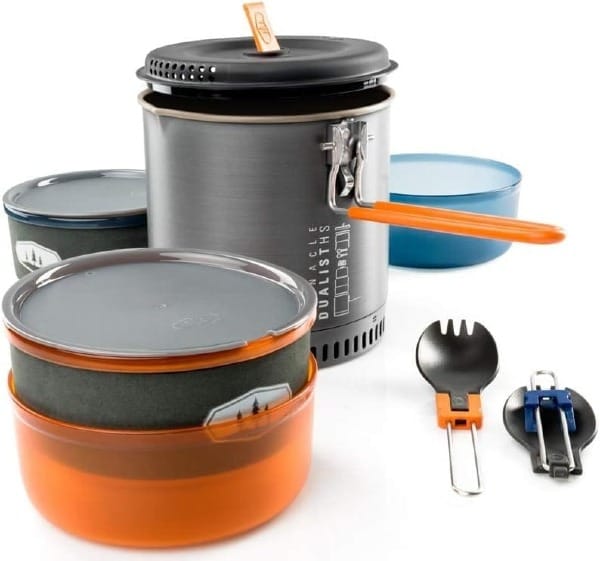
Key Features:
- Heat exchanger-equipped pot for fast, efficient cooking
- Complete set including pot, bowls, cups, lids, and sporks
- Nesting design with room for a stove and fuel canister
- Carrying case doubles as a wash basin
Pros:
- Exceptional heat efficiency reduces fuel consumption and boiling time
- Comprehensive set with everything two people need for cooking and eating
- Space-efficient design with impressive nesting capability
- Relatively lightweight considering everything included
Cons:
- More expensive than simpler pot options
- May contain more pieces than solo campers need
- The heat exchanger can be damaged if not protected during transport
Bottom Line: The GSI Outdoors Pinnacle Dualist HS is the ideal all-in-one solution for backpacking duos who want to minimize weight while enjoying hot, efficiently prepared meals. The heat exchanger technology sets it apart from competitors, making it worth the investment for frequent backpackers.
2. KingCamp Stainless Steel Cookware Set
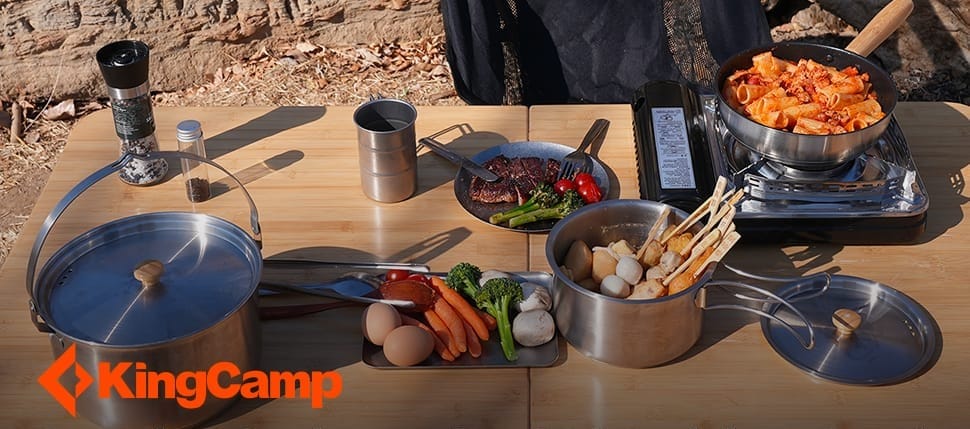
Key Features:
- Made from high-quality 304 stainless steel
- Natural bamboo wood handles for style and heat resistance
- Non-stick coating on the pan
- Comprehensive set with multiple pots, a pan, and a strainer
- Tri-ply construction with aluminum core
Pros:
- Superior durability from quality stainless steel construction
- Eco-friendly bamboo handles add style and functionality
- Excellent heat distribution thanks to the aluminum core
- Versatile enough for both camping and home use
- Compatible with induction hobs
Cons:
- Heavier than aluminum or titanium options
- Bulkier than minimalist backpacking sets
- Maybe more cookware than needed for simple trips
Bottom Line: The KingCamp Stainless Steel Cookware Set shines for car camping and basecamp cooking, where weight isn't a primary concern. It offers exceptional durability and cooking performance with enough pieces to prepare elaborate meals for small groups.
3. Sea to Summit Alpha Cookset 1.1
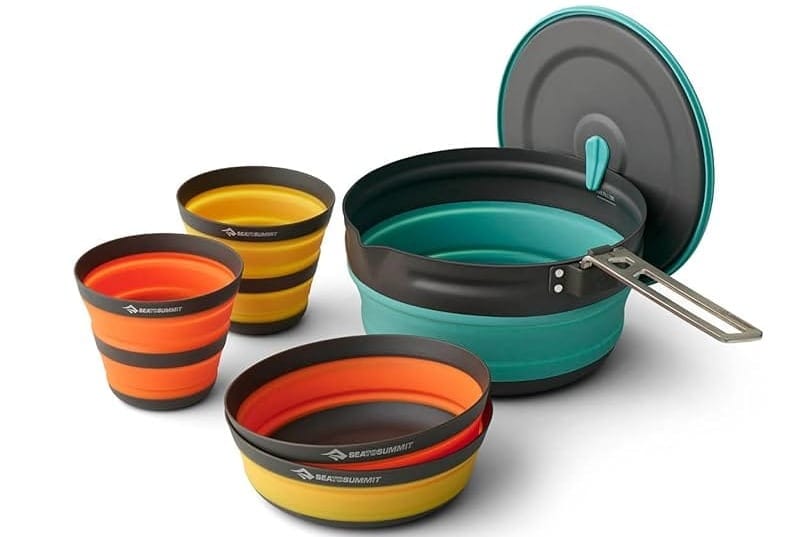
Key Features:
- Compact, all-in-one solution for solo adventurers
- 1.2L hard-anodized alloy pot
- Includes Delta Light Bowl and insulated Delta Mug
- Pivot-Lock handle for secure cooking and compact storage
- Slotted strainer lid
Pros:
- Impressively compact nesting design (only 10 cm tall when packed)
- Lightweight yet durable hard-anodized construction
- Clever Pivot-Lock handle system
- Complete cooking and eating solution for one person
- Easy to clean with smooth surfaces
Cons:
- Limited capacity for group cooking
- May not include enough volume for more elaborate meals
- Premium price compared to basic pot options
Bottom Line: The Sea to Summit Alpha Cookset 1.1 is perfect for solo backpackers who want a complete, compact cooking system without excess weight or bulk. Its thoughtful design features show a deep understanding of backcountry cooking needs.
4. Snow Peak Titanium Trek 900
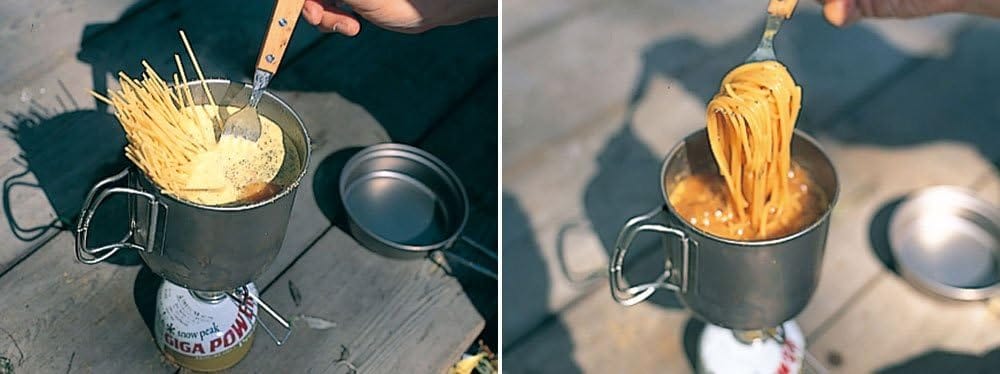
Key Features:
- Ultralight titanium construction
- 900ml capacity
- Compact design with storage capabilities
- Minimalist approach focused on weight savings
Pros:
- Exceptionally lightweight for its capacity
- Durable titanium construction resists corrosion and damage
- Perfect size for solo cooking with enough volume for real meals
- Ample internal storage space for the stove and other items
- Titanium doesn't impart flavors to food
Cons:
- No bail handle option (preferred by some users)
- The lid doesn't always stay securely in place
- Premium price due to titanium construction
- Simple design without extra features
Bottom Line: The Snow Peak Titanium Trek 900 is the ultralight backpacker's dream pot, offering the perfect balance of capacity and weight. Its simple, durable design will last for years of adventures, making it worth the higher initial investment.
5. Stansport Stainless Steel Cook Set

Key Features:
- Budget-friendly complete cookset
- Includes 2.1-liter pot, 8-inch frying pan, and lid
- Comes with cups, bowls, and utensils
- Stainless steel construction with non-stick coating
Pros:
- Remarkably affordable price point for a complete set
- Includes dinnerware and utensils—great for beginners
- Acceptable cooking performance for casual camping
- Compact design with locking mechanism
Cons:
- Contains Teflon (PFAS) in non-stick coating
- The plastic handle feels less secure than other options
- Limited to one pot and one skillet
- Not as durable as premium options
Bottom Line: This Stainless Steel Camp Cookset offers exceptional value for occasional campers or those just building their camp kitchen. While not the most durable or feature-rich option, it provides everything needed to get cooking outdoors at a price that won't break the bank.
Frequently Asked Questions
Q: What's the best material for camping pots?
Answer: The "best" material depends on your specific needs and priorities:
Titanium is ideal for backpackers focused on minimizing weight. It's incredibly light, highly durable, and doesn't corrode, but it's also the most expensive option and can develop hot spots while cooking.
Aluminum strikes a good balance between weight and affordability. Hard-anodized aluminum adds durability and makes the surface non-reactive with acidic foods. It's lightweight and conducts heat well, but it isn't as durable as titanium or stainless steel.
Stainless Steel excels in durability and value. It's heavier than the alternatives but can take serious abuse without showing wear. Many stainless steel pots feature an aluminum core for better heat distribution, offering the best of both materials.
For car camping, where weight isn't a concern, stainless steel is excellent. For backpacking, consider titanium for ultralight trips or hard-anodized aluminum for a more budget-friendly option that still keeps weight down.
Q: How do I clean my camping pots in the backcountry?
Answer: Proper backcountry cleaning preserves your cookware and protects the environment:
Scrape out food residue: Use a spoon or dedicated scraper to remove as much food as possible.
- Add water and heat: For stubborn residue, add a small amount of water to your pot and heat it to loosen stuck-on food.
- Scrub gently: Use a small sponge, bandana, or dedicated scrubber.
- Use biodegradable soap sparingly: If necessary, use a tiny amount of biodegradable camp soap.
- Rinse thoroughly: Use clean water to rinse away any soap or food particles.
- Dry completely: Always dry your cookware thoroughly before packing to prevent mold and corrosion.
Q: Can I use my camping pots on my home stove?
Answer: Yes, most camping pots can be used on home stoves, but there are some considerations:
- Stainless steel and aluminum pots work well on virtually any home stove, including gas, electric, and induction (for magnetic stainless steel).
- Titanium pots function on home stoves but may develop hot spots due to their thinner construction.
- Camping pots with heat exchangers work on home stoves but won't provide the same efficiency advantage they offer with camp stoves.
- Non-stick coatings used in some camping cookware may wear faster on high-output home stoves, so moderate heat is recommended.
Q: How many camping pots do I really need?
Answer: For most campers, a streamlined cooking system is preferable to carrying multiple specialized pieces:
Solo Backpackers: A single 0.9-1.5 liter pot is usually sufficient.
Couples/Pairs: A 1.5-2 liter pot covers most needs.
Family/Group Camping: Consider a 2-3 liter pot plus a frying pan.
Remember that each additional piece adds weight and bulk to your pack. Many experienced backpackers find that a single well-chosen pot with a lid (that might double as a frying pan) meets 90% of their needs.
Q: Are non-stick camping pots safe and durable?
Answer: Non-stick coatings offer convenience but come with considerations:
Safety: Traditional PTFE (Teflon) coatings have raised health concerns, particularly when overheated above 500°F (260°C), which can happen on high-output camp stoves. Newer PFOA-free coatings address some concerns, while ceramic non-stick alternatives offer a different option altogether.
Durability: Non-stick coatings are invariably the first part of a camping pot to fail. In the rough conditions of outdoor cooking and packing, these coatings may scratch or wear off, especially when metal utensils are used or pots are stacked without protection.
Many experienced backcountry cooks prefer uncoated titanium, aluminum, or stainless steel pots for their durability, even if they require a bit more oil during cooking and more effort during cleaning.
Conclusion
Happy camping and bon appétit!
